| |
|
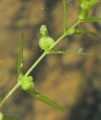 | |
| MaltaWildPlants.com by Stephen Mifsud |

|
| |
|
|
 |  |  |  |
| External Links: |
|
Colchicum cupanii (Mediterranean meadow saffron) |
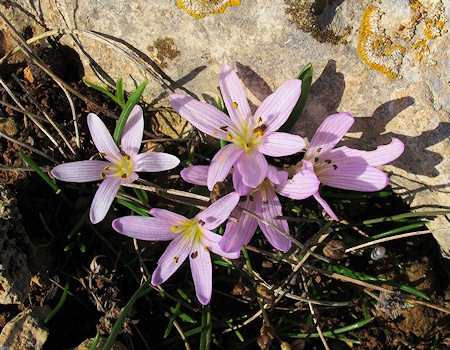
Colchicum cupanii (COLCHICACEAE.)
Images for this profile are taken from the Maltese Islands after year 2000. |
|
| Nomenclature |
Species name : | Colchicum cupanii Guss. | Authority : | Giovanni Gussone, Italy, (1787 - 1866) | Synonyms :
(basionym or principal syn.) |
|
Plant Family : | Colchicaceae DC. (= Liliaceae )
(Colchicum Family) | English name(s) : | Mediterranean meadow saffron | Maltese name(s) : | Busieq, Buswieq tax-xitwa | Status for Malta : | Indigenous. Present on the Maltese islands before man | Name Derivation : |
Colchicum: from or related to Colchis, a region east of the Euxine part of Turkey and west of Georgia. First plants of this genus described from this region. (Latin origin ); 2 = from or related to Colchis: a region east of the Euxine (Turkey) or west Georgia (Latin);.
cupanii: Named after the monk Francis Cupani (1657-1710), who dedicated his life studying natural sciences. He became the director of the botanical gardens of Misilmeri, near Palermo and author of the impressive work Hortus Catholicus. (Latin origin ); 2 = Named after Fr. Francis Cupani (1657-1710), a student of the natural sciences, was the director of the botanical gardens of Misilmeri, near Palermo and author of the impressive work Hortus catholicus. The herbal stock Cupani is named for him. (Latin).
| Remarks : | |
|
| Morphology and structure |
PLANT STRUCTURE: |
Character | Growth Form | Branching | Surface |
Description | | | |
General
Picture |  | 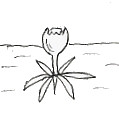 |  |
|
LEAVES: |
Character | Arrangement | Attachment | Venation |
Description | | | |
General
Picture | 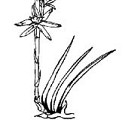 | 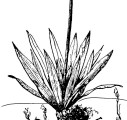 |  |
| |
Character | Leaf Shape | Leaf Margin | Remarks |
Description | | | |
General
Picture |  |  |  |
|
FLOWERS: |
Character | Colour | Basic Flower Type | No. of Petals | No. of Sepals |
Description | Lilac / Lavender Colour varies from rose-pink to lavender to lilac-white. | | 6 To be botanically precise, the flower has 3 sepals (outer whorl) and 3 petals (inner whorl) which are identical, and so they are collectively referred to as 6 tepals or perianth segments. | 0 |
General
Picture | | 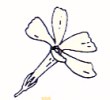 |  |  |
| |
Character | Inflorescence | Description | Ovary | Stamens |
Description | | The flower consists of a relatively long white narrow tube which opens up into a lilac flower with 6 well separated similar tepals. It hase 6 firm stamens with yellow anthers and 3 free styles that are slightly twisted. | | |
General
Picture |  |  | 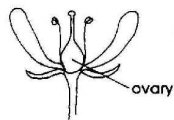 |  |
| |
Character | Scent | Average Flower Size | Pollen Colour | Other Notes |
Description | YES It has a sweet nectar which attracts ants. | 24mm | Yellow | - |
|
SEEDS: |
Character | No. Per Fruit | Shape | Size | Colour |
Description | 1-6 | Tooth-shaped Cylindrical with one end flat and the apical end being rounded or pointed. They have a hard wrinkled texture. | 3-4 mm | Brown |
General
Picture |  |  |  |  |
|
FRUIT AND OTHER BOTANICAL DATA: |
Character | Fruit Type | Colour of Fruit | Subterranean Parts | Other Notes |
Description | | Gteen | | - |
General
Picture | 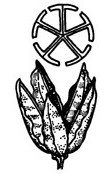 |  | 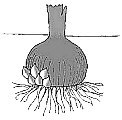 |  |
|
|
| Plant description and characters | |
Life Cycle: | Perennial. |
Growth Form: | GEOPHYTE (bearing underground bulbs, rhizomes, stolons, etc.) |
Habitat: | Garigue, Steppe, Cliff tops and Damp soil in rocky gaps and pockets. |
Frequency: | Common |
Localities in Malta: | Garigues as at Siggiewi, Dingli Cliffs and Mtahleb. |
Plant Height: | 6-10cm. |
| Oct-Nov |
Protection in Malta: | Not legally protected till the last update of this website (2/Mar/2022) |
Red List 1989: | Not listed in the Red Data Book of the Maltese Islands |
Poison: | |
This miniature plant is just 8cm long and is seen for a short period of around 3 weeks in the months of October/ beginning of November. The plant consists only of a pair of opposite leaves and a rose-lilac flower all emerging from a small underground bulb with several roots. At the zone of emergence (that is ground level) there is a protective pale green sheath covering the base of the leaves and flowers. The plant has no stem, both leaves and flowers grow directly from the underground bulb.
The plant form a pair of leaves (seldom 3 leaves) running opposite to each other with the flower located at their middle. The leaves are linear and tapering, flat or slightly V-shaped in cross section, 3-8mm broad and 8cm long , glabrous and usually curve down.
The stemless flowers measure 20-25mm across and consists of an elongated white neck which goes down into the underground bulb, and a flower of 6 tepals which thier colour varies from rose-pink, to lavender to lilac-white; the most common being lilac or lavander. The tepals have a blunt tip and several longitudinal grooves. The flower's reproductive organs consists of 6 stamens and 3 styles. The stamens are made up of firm white filaments and light brown anthers covered with yellow pollen. Nectar is secrteted from the stamens and often, ants are seen roaming upon them. The 3 independent styles are white, slightly twisted and have a yellow stigma at their tip. The plant usually form one flower, sometimes 2 and rarely 3.
The overall appearance of the flowering plant is hence two opposite, linear leaves that are curved downwards and a lilac flower with a white neck that goes between the leaves down to the underground bulb. These plants usually grow in groups and are seen as several cute lilac flowers lying on a large area on the ground.
The flower tube travels down to the ovary which lies just below or at soil level between the 2 leaves. It forms a dehiscent fruit capsule which initially is hidden under the soil or between the leaves, but emerges our when it starts growing. At around January (in Malta) the fruit is clearly visible. It consists of 1, 2 or maximum of 3 peanut shaped rounded capsules with a somehow tapering end. They are dark brown to black when fully mature. They split open and make it possible for the numerous stored seeds to be liberated. They are carried away by wind or rain water usually to small distances in February. Seeds are black and very poisonous!
|
|
| Information, uses and other details |
Colchicum and Crocus resemblance
At first glance Colchicum and Crocus species may look very similar and can be associated together. They are both violet, purple or lilac flowered monocots but the Crocus are part of the Iridaceae (Iris) and the Colchicum are derived from the Liliaceae (Lily). This fact of confusion is seen in the common name given to the well known Colchicum autumnale which is known as Autumn Crocus. The truth is that it is not a Crocus at all. [SM] Colchicum generally resembles to an oversized, fall-blooming crocus, but in fact the two are quite distant both genetically and ornamentally. [WWW-83]
Colchicum cupanii var. pulverulentum
A variation of C. cupanii exist and is described similar but differing from the type by undulate leaf margins and they are minutely hairy. It is found in Tunesia. [WWW-82]
Colchicum species possess Colchicine
Colchicum species contain an important substance used as a drug but is also highly toxic at high doses. [274] The main source of Colchicine is the plant species Colchicum autumnale (autumn Crocus or Meadow saffron) but is likely that C. cupanii also possess colchicine, perhaps in less concentration. For this purpose, account of colchicine is given below. [SM]
Activities of Colchicine
Colchicum species were considered by the ancients as powerful toxins but know it is used for medicine [274]. The activities of Colchicine are numerous and the following are described by A.R.S. - [WWW-66] :
AntiBehcet's, AntiHIV (Dosage: EC50=0.01 uM), AntiPaget's (Dosage: 600 ug/3x/day/man), Antiamyloidosic, Antiarthritic, Antibacterial, Anticirrhotic (Dosage: 1-2 mg/man/day), Antidermatitic, Antierythemic, Antiherpetic, Antiinflammatory, Antileukemic, Antimalarial (Dosage: 500 ug/10x/day/man), Antimelanomic (Dosage: ED50=0.18 ug/ml), Antimeningitic (Dosage: 500 ug/2x/man/day), Antimitotic (Dosage: 2 mg/kg scu mus), Antipericarditis (Dosage: 500-1,000 ug/man/day), Antipodagric (Dosage: 3-6mg man/day), Antipolyserositic (Dosage: 500-600 ug/2-3 x day/man), Antipsoriac, Antipyretic, Antirheumatic, Antisarcomic (Dosage: ED50=0.047 ug/ml), Antithrombocytopenic (Dosage: 600 ug/2-4x/man/day), Antitrypanosomic, Antitubulin (Dosage: IC50=2.4 uM), Antitumor - Breast (Dosage: ED50=0.022 ug/ml), Antitumor - Colon (Dosage: ED50=0.0071 ug/ml), Antitumor - Lung (Dosage: ED50=0.043 ug/ml), Antivasculitic (Dosage: 600 ug/2x/man/day), CNS-Paralytic, CNS-Stimulant, Carcinogenic, Cardioactive (Dosage: 15 mg/kg), Cytotoxic (Dosage: IC50=0.018 uM), Emetic, Hepatoprotective, Hypertensive, Irritant, Purgative, Respiradepressant, Sympathomimetic, Uricosuric.
Effect of Colchicine on genetic material
If colchicine is applied to seeds or growing points of plants has the effect of doubling the chromosome numbers of young dividing cells. It effects the division of the cell nuclei so that the chromosomes do not seperate to produce cells with multiples of the normal number of chromosomes. It is of great importance in plant breeding for it causes permanent genetical changes in the tissues which may be of value in agriculture and horticulture research. [273, 274].
Toxicity of Colchicine
The plant contains the highly toxic substance - Colchicine which its lethal dosage is given as follows [WWW-66] :
- LD50=1.6 mg/kg (ivn rat)
- LD50=4.13 mg/kg (ivn mus)
- LDlo=0.186 (orl hmn)
- LDlo=7 mg/man
- LD50=0.13 mg/kg(oral cat)
- LD50=66.6 mg/kg (oral mus)
- LDlo = Lowest published toxic dose
- LD50 = Lethal dose, 50 percent kill
Other lethal doses and detailed toxicity can be seen in the following reports:
1) National Institute for Occupational Safety and Health
2) www.hazard.com
As in Colchicum autumnale, the toxic compound is likely to be found in all plant parts, especially in the seeds and corm. For adults, a dose of only 5 grams of Colchicum seeds can prove fatal. For a child, the lethal dose is 1 to 1.5 grams. A mere 200 milligrams of the active ingredient Colchicine is sufficient to cause death. [WWW-81]
The first signs of poisoning appear 3 to 6 hours after intake of a toxic amount, when the victim develops a burning feeling in his mouth, has difficulty swallowing, and begins to experience intense thirst. After 12 to 14 hours, nausea and vomiting set in, accompanied by severe stomach pains, diarrhea, bladder spasms, blood in the urine, a fall in blood pressure, and, eventually, progressive paralysis. Death follows from exhaustion, asphyxiation, and circulatory collapse. [WWW-81]
Bedford Laboratories have produced a medicine in the form of injections based on pure Colchicine to treat gout. In the warnings and precautions leaflet supplied with the medicine they give a good account about Colchicine and its toxicity. They state that the lethal dose of Colchicine is estimated to be 65mg per person, though the lowest dosage reported to have been fatal for a human was as low as 7mg. You can read the whole suppliment document about Colchicine injections USP by Clicking here. [WWW-80]
A hazard fact sheet of colchicine is postulated by New Jersey Department of Health and Senior Services and can be read by (clicikng here)
There are several reports describing cases of death due to poisoning from Colchicum species or other plants which have colchicine. Below are some abstracts of such reports and studies:
- Case report: fatal poisoning with Colchicum autumnale (Miran Brvar et al. ) (full report)
- Colchicine poisoning by accidental ingestion of meadow saffron (Colchicum autumnale): pathological and medicolegal aspects. (Michael Klintschar et al.) (full report)
- Accidental plant poisoning with Colchicum autumnale: report of two cases. (Brncic N et al.)
- Colchicine poisoning resulting from accidental ingestion of meadow saffron - Colchicum autumnale. (Sannohe S. et al.)
- Colchicine poisoning by accidental ingestion of the bulbs of Sandersonia aurantiaca (Fujita K. et al.)
- Acute poisoning with autumn crocus Colchicum autumnale L. (Brvar M et al.)
- Accidental poisoning with autumn crocus (Gabrscek L et al.)
Adverse reactions
These are usually gastrointestinal in nature and consist of abdominal pain, nausea,
vomiting, and diarrhea. The diarrhea may be severe. The gastrointestinal symptoms
may occur even though the drug is given intravenously; however, such symptoms are
unusual unless the recommended dose is exceeded.
Prolonged administration may cause bone marrow depression, with agranulocytosis,
thrombocytopenia, and aplastic anemia. Peripheral neuritis and depilation have
also been reported.
Myopathy may occur in patients on usual maintenance doses, especially in the
presence of renal impairment. [WWW-80]
Signs, Symptoms and Treatments of Colchicum
Symptoms, the onset of which may be delayed, include nausea, vomiting, diarrhea, abdominal pain, hemorrhagic gastroenteritis, and burning
pain in the throat, stomach, and skin. Fluid extravasation may lead to shock.
Myocardial injury may be accompanied by ST-segment elevation, decreased contractility,
and profound shock. Muscle weakness or paralysis may occur and progress to
respiratory failure. Hepatocellular damage, renal failure, and lung parenchymal infiltrates
may occur and, by the fifth day after overdose, leukopenia, thrombocytopenia,
and coagulopathy may also occur. If the patient survives, alopecia and stomatitis may
be experienced. There is no clear separation of nontoxic, toxic, and lethal doses of
colchicine. [WWW-80]
According to reference [326] the symptoms and treatments of Colchicine are as follows:
Symptoms: Buming in mouth and throat with dryness and difficult swallowing; nausea and incessant vomiting and purging; pulse small and irregular, pupils dilated, great
prostration.
Treatment: Lavage of stomach, castor oil, tannin, demulcents; stimulants, strychnine, caffeine, morphine and atropine.
Description of Colchicum by the Eclectic Materia Medica, Pharmacology and Therapeutics.
Source:
The dried (I) root and (II) seed of Colchicum autumnale, Linné (Nat. Ord. Liliaceae.) England and other parts of Europe. Dose, Corm, 1 to 5 grains; seed, 1 to 5 grains.
Common Names:
I. Colchicum Corm (Colchici Cormus); II. Colchicum Seed (Colchici Semen).
Principal Constituent:
The powerful alkaloid Colchicine (see below.)
Derivative:
Colchicina, Colchicine. A very toxic alkaloid occurring as pale yellow scales or powder, practically odorless. It should not be tasted. Soluble in water. The
salicylate is sometimes employed. Dose, 1/300 to 1/100 grain.
Preparation:
Specific Medicine Colchicum. Dose, 1 to 10 drops.
Specific Indications:
Acute gout; rheumatism, without much fever, occurring in gouty individuals; tearing pain, aggravated by heat.
Action and Toxicology:
Upon the skin and mucosa colchicum is irritant, causing smarting and redness, sneezing and conjunctival hyperemia. Small doses increase the
secretions of the skin, kidneys, liver, and bowels. Large doses are dangerous, producing gastric discomfort, nausea and vomiting and purging, and violent peristalsis with much
intestinal gurgling. Poisonous doses produce a violent gastro-enteric irritation, with symptoms much like those of cholera-agonizing griping, painful muscular cramps in the legs and feet, large but not bloody evacuations of heavy mucus and serum, thready pulse, collapse, and death. Toxic doses are almost sure to kill in spite of efforts to save life, the patient dying a slow, painful, and agonizing death, the final act of which is respiratory paralysis. Consciousness remains to the end.
The reputed antidote is tannin freely administered with plenty of water and followed by the use of emetics or the stomach pump. Opium may be given to relieve pain,
atropine to sustain breathing, and artificial heat to maintain bodily warmth.
Therapy:
Colchicum is an extremely dangerous medicine and should be used with the greatest of caution. It is the remedy for acute gout, temporarily giving quick relief if
administered short of purgation. For some unknown reason attacks recur more frequently when colchicum has been used, though it almost magically relieves the paroxysms.
It is useful for disorders depending upon a gouty diathesis, though it is less effectual in chronic gout than in the acute form. In rheumatism, pure and simple, it usually has little or no value, though we have had excellent results after failure with the usual antirheumatics, in cases where pain persisted in one part for longer periods than usual, in acute articular rheumatism with but little fever. These cases resembled gonorrheal arthritis and were accompanied by a leucorrheal discharge, but were not gonococcic. In most cases the fingers, wrists, and abdomen were the most painful locations. Some have advised it in so-called chronic rheumatism when the patient is known to have occasional gouty attacks. We have seen it do good in rheumatoid arthritis; a condition much more prevalent in this country than genuine gout, a disease rarely encountered in America. In rheumatoid headache and in rheumatic iritis colchicum is sometimes of value when occurring in one with swollen joints, with or without effusion, and attended by tearing, muscular pain, aggravated by heat. Subacute and chronic sciatica are asserted to have been relieved by colchicum when the pain is sharp, shooting, tearing, or dull, from back to hips and down the legs, fever being absent. In rheumatic conditions colchicine salicylate in doses of the 1/128 grain is often more serviceable than colchicum.
Information supplied by Henriette's Herbal [WWW-18]
Description of Colchicum by The British Pharmaceutical Codex.
Description:
Colchicum corm is obtained from the meadow saffron, Colchicum autumnale, Linn. (N.O. Liliaceae), a plant distributed over Central and Southern Europe and common in parts of England. It is also official in the U.S.P., when it should contain not less than 0.35 per cent. of colchicine. It should be collected in the early summer, and, for use in the dried state, stripped of its coats, sliced transversely, and dried at a temperature not exceeding 65°. The fresh corm is about 3 centimetres long and 25 millimetres broad, bluntly conical in shape, flattened on one side and enveloped in an outer, brown, and inner, reddish-yellow, membranous coat. The interior is white and fleshy, exuding when cut a bitter juice, milky from the presence of starch grains. The odour is disagreeable. The dried drug occurs in whitish slices, 2 or 3 millimetres thick, yellowish on their outer surface, and reniform in outline. They break with a short starchy fracture, are odourless, but have a bitter taste.
Constituents:
The chief constituent of colchicum corm is the yellow amorphous alkaloid colchicine, of which it contains from 0.5 to 0.6 per cent. Starch is also present.
Action and Uses:
olchicum is a specific in acute gout. It relieves the pain and inflammation, cutting short the attack, but does not increase the quantity of the urine or the
amount of uric acid excreted (see also Colchicina). Colchicum may cause considerable gastro-intestinal irritation with vomiting and purging. Its use for long periods is not
recommended, owing to its paralytic action upon the central nervous system. The dried corm in powder may be administered in pills or the drug may be prescribed as
Vinum Colchici or Extractum Colchici. Colchicum is an ingredient of many advertised gout remedies. The use of henbane or belladonna with colchicum removes the
tendency to intestinal irritation, since colchicum, like jaborandi, excites the vagal nerve endings in the gut, and these same nerves are paralysed by atropine. Generally,
preparations of colchicum corm are best given with a purge. In cases of poisoning by colchicum, the stomach should be emptied; atropine should then be given, this drug
entirely eliminating the effect of colchicum on the alimentary canal, indeed it is as direct an antidote to colchicum in this respect as it is to pilocarpine. If cerebral depression is
considerable injections of caffeine should also be made.
Information supplied by Henriette's Herbal [WWW-18]
Personal Observations
Use of Colchicum cupanii in Medicine
There is no report that Colchicum cupanii is used in medicine. However, since Colchicum species have the pharmacologocially important substance - Colchicine, the C. cupanii can theoretically be used to extract Colchicine and use it for medicinal purposes. The lack of use of C. cupanii for Colchicine is probably due to the fact that it offers yield disadvantages and these might be: [SM]
- Low yield of colchicine
- Plant or relaitively corm too small
- Contains relatively low amounts of Colchicine that makes yield not favourable
- The seeds are difficult to obtain, usually burried few cm below soil level
- Extraction is difficult
- No research has been done regards the the yield of colchicum from this plant.
The main source of colchicine is the seeds and corms of C. autumnale (Autumn crocus). There has been a study which determined the level of colchicine in other Colchicum species that are C. hierosolymitanum and C. tunicatum and the results obtained were 0.766 mg/g and 0.688 mg/g respectively [324].
Another study assayed the substance in the C. stevenii and C. hierosolymitanum and the results were as follows. With respect to C. steveni, the leaves contained the largest amount of colchicine (0.204/100 g or 2.04mg/g), whilst in C. hierosolymitanum corms showed the highest colchicine content (0.126/100 g or 1.26mg/g). As a source of colchicine, the two investigated species showed levels comparable with those found in C. autumnale, the traditional source of colchicine. [325]
Hence althoughC. cupanii is very likely to contain Colchicine, its level are yet to be researched [SM]
Seeds of the plant
The seeds of this plant is practically near to impossible to collect in the wild. The styles of the flower run down through the elongated hollowed white flower tube down to the ovary which lies few centimetres below or at soil level. In some Cochlicum species (eg: C. autumnale) the fruit emerges up from soil level, while in others it remains burried or at soil level in situ. It is not yet certain where the fruit capsule and seeds of C.cupanii are found. In any case when the fruit is ripe, the leaves would have already been wilted and the soil would be covered by other vegetation. Localizing the fruit of the wild plant in situ would hence be very difficult. [SM]
Varieties and hybridization in the wild
Colchicum species are well known for its hybridization between different species. There is also plenty of varieties and some species maybe are just natural hybrids and varieties occuring in the wild. This might be the case also in Malta. Although no botanical research have been done, the phenotype of some flowers is like between two extremes. Also some flowers look as to belong to another described species. This photo (click here) consists of 2 flowers - one is a flower described as C.cupanii found in Dingli. It has very similar appearance to the other photo - found on Pacific Bulb Society [WWW-84] - which is described as Colchicum glossophyllum. The author of the source states: "One authority says it is a variant of C. cupanii; however, as you can see in the photo, the leaves are much broader and longer at anthesis than is typical of C. cupanii as I have seen it. " Although photos are not ideal for comparing flowers, there is a lot of common between the 2 photos. Further botanical research of this plant would be very interesting [SM]
|
|
| Links & Further literature
(0 papers) |

Google Web |

Google Images |

Google Scholar |

Research Gate |

Wikipedia |

JSTOR |

GBIF |

Med Checklist |

Cat. of Life |

EoL |

IPNI |

World Flora Online |

Plants of the World Online |

Vienna Virt. Herb. |

RBGE Herbarium |

KEW Herbarium |

MNHN |

Arkive |

IUCN |

CABI |
Kindly Email if there are papers and publications about local
studies or information about this species to be included in the list above.
|
| Photo Gallery (41 Images) |  |
 |
 |
 |
IMAGE: CLCCU-01 A very good photo which describes the whole plant. This Colchicum species is a very low (5-8cm) plant with one or 2 lilac flowers and a pair of opposite running leaves emerging from the underground bulb. Also note the protective sheath covering the base of the flowers and leaves. |
IMAGE: CLCCU-02 Top view photo of flower. it consists of 6 petals which their colour varies from white, lilac, rose-pink or lavender. |
IMAGE: CLCCU-03 Photo of plant with 2 flowers. It is more common that the plant forms one flower rather than 2. The colour of this flower is between rose and lavender. |
IMAGE: CLCCU-04 Side-view photo of plant having a lavender flower with a whitish neck. The plant forms 2 linear or lanceolate-linear leaves running opposite each other. They are usually flat and untwisted. More leaves pairs are seen emerging from the soil. |
 |
 |
 |
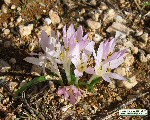 |
IMAGE: CLCCU-05 Photo of rose-coloured flower. Flower forms of this colour is quite rare; the most common being lavender/lilac, and nearly white. |
IMAGE: CLCCU-06 Photo of flower (top-view). It consists of 6 tepals, 6 anthers (each being made of a white filament and a light brown anther covered with bright yellow pollen), and three slightly twisted styles tipped with an inconspicuous yellow tipped stigma. |
IMAGE: CLCCU-07 Photo of flower in situ. |
IMAGE: CLCCU-08 Photo of a group of plants growing close to each other forming a natural bouquet in situ. |
 |
 |
 |
 |
IMAGE: CLCCU-09 Photo of isomorphic (x6) flower showing its lilac tepals with yellow base, and its 6 stamens with dark purple anthers. 3 thread-like white styles are at the centre and inconspicuous. |
IMAGE: CLCCU-10 Photo of the plant which consists of a single flower and 2 opposite leaves. |
IMAGE: CLCCU-11 Photo of 2 plants beside each other. Each bulb can propagate by forming other bulbs beside it which give rise to a new plant. |
IMAGE: CLCCU-12 Photo of the same plants in the previous photo (side-view). |
 |
 |
 |
 |
IMAGE: CLCCU-13 A cluster of plants with different flower colours. |
IMAGE: CLCCU-14 Close-up of flowers with different colours. |
IMAGE: CLCCU-15 A cluster of plants with flowers of more or less similar colour. |
IMAGE: CLCCU-16 A specimen with pure white flower colour. |
 |
 |
 |
 |
IMAGE: CLCCU-17 A specimen with very pale lilac flower colour. |
IMAGE: CLCCU-18 A specimens with lilac flower colour. |
IMAGE: CLCCU-19 Specimens with flowers having a pink colour. |
IMAGE: CLCCU-20 Lateral view photo of plant showing one fully mature flower and another in bud. From Qala, Gozo. |
 |
 |
 |
 |
IMAGE: CLCCU-21 A rather dense clump of specimens. |
IMAGE: CLCCU-22 Close up of flower. |
IMAGE: CLCCU-23 A another group of plants with purple-pinc flowers. |
IMAGE: CLCCU-24 Photo of another specimen from Ta' Cenc, Gozo. |
 |
 |
 |
 |
IMAGE: CLCCU-25 Scanned and annotated image of 2 plants. arrow show the level of soil. |
IMAGE: CLCCU-26 Scanned image of narrow leaves. The one shown in the photo measure 40mm long and 4mm wide. |
IMAGE: CLCCU-27 Scanned image of flower which have a long neck that reaches the bulb under the ground. The style passes through the flower tube and reaches the ovary at the bulb. |
IMAGE: CLCCU-28 Scanned image of flower showing mainly the perianth and the stamens. |
 |
 |
 |
 |
IMAGE: CLCCU-29 Scanned image of flower (lateral view) with one petal removed. Stamens grow from and run along the length of perianth segments ('petals'). |
IMAGE: CLCCU-30 Scanned image of flower which is dissected and divided in two. It clearly shows the 3 filament-like white styles at the centre of the flower. Note the yellow band at the base of the stamens' filaments. |
IMAGE: CLCCU-31 Photo of several plants in Winter (Jan 2006). The leaves continue to grow and will attain a characteristic twist along their longitudinal axis. The fruit capsule develops at the centre of the plant. |
IMAGE: CLCCU-32 Photo of a plant taken at Giordan Lighthouse, Gozo. After the early flowering period in Nov, the leaves grow further to about 12cm in length and the fruit capsules develops centrally at ground level. |
 |
 |
 |
 |
IMAGE: CLCCU-33 Photo of a single mature plant taken at the beginning of January 2006 (Dingli Cliffs). |
IMAGE: CLCCU-34 Photo of a young plant. |
IMAGE: CLCCU-35 Photo of fruit capsules at the centre of the plant. They are rounded dark brown bodies, with the size of a peanut. |
IMAGE: CLCCU-36 Close up photo of the fruit. 2 capsules are present in this plant. Note the dried light-brown remains of the flower. |
 |
 |
 |
 |
IMAGE: CLCCU-37 Photo showing the habitat of the plant. Here are plenty of plants growing in low damp soil found over garigue and steppe during late October and beginning of November. |
IMAGE: CLCCU-38 Photo of a population often accompanied by other autumn plants like Ranunculus bullatus, Narcissus serotinus (not in this picture) and Prospero autumnalis. |
IMAGE: CLCCU-39 Photo of habitat of plant showing some individuals. Note the variation in colour of different flowers. |
IMAGE: CLCCU-40 Photo of habitat of plant showing several plants. This species can be seen for a very short period of time (about 3 weeks), just after the flowering period of Prospero autumnalis is finished. |
 |
| | | IMAGE: CLCCU-41 Magnified image of pollen under SEM. It has more or less a cylindrical shape and pitted surface. Taken from Flora apistica della Sicilia (by Prof. Nunzio Longhitano). |
IMAGE: CLCCU-42 |
IMAGE: CLCCU-43 |
IMAGE: CLCCU-44 |
|
| | |

